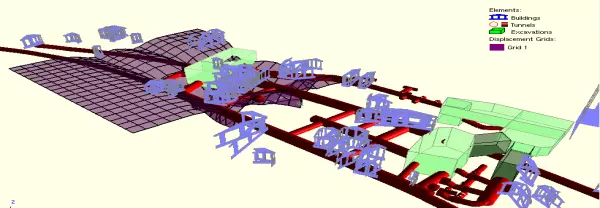Oasys xdisp 19.3.1.27
Save time and eliminate errors with automatic predictions for ground movement, settlement analysis and structural damage

Xdisp saves time and money by eliminating the need for different programs and multiple spreadsheets when predicting ground movements, settlement analysis and building damage.
Xdisp: transforming ground movement and structural damage prediction
To estimate the effect on surrounding structures, most urban tunnelling or excavation work requires ground movement and structural dama ge assessments. But producing them with different analysis programs and spreadsheets can be time consuming and make calculations difficult to check. Xdisp automates the process and displays the data in clear 3-D graphics.
Formerly known as Tunset, the program predicts ground movements due to all kinds of excavations, including tunnels, basements, mines and embedded walls. It then uses these soil movements to assess building damage, eliminating the need for separate analysis programs or multiple spreadshe ets. 3-D graphics make it easy to check and interpret the data, as well as helping to make things clear for designers, contractors and clients.
Drawing on Arup’s experience of complex urban tunnelling projects in London, New York and Hong Kong, Xdisp has been used successfully on Crossrail and King’s Cross underground station in London as well as numerous underground railway and building projects around the world.
Tunnels and Mines
Tunnels can be modelled as cylindrical excavations in soil. Xdisp defines the settlement profile at the surface or specified depth based on estimated volume loss above the tunnel due to deformation.
Mines are taken as excavations of rectangular cross-section in rock. Xdisp uses an analysis based on the stochastic influence approach to predict subsidence and horizontal displacement.
Embedded Wall Excavations
Embedded wall excavations are modelled in plan as polygons with a level at each corner or circular vertical shafts. Each is assigned horizontal and vertical ground movement curves that are used to calculate soil settlements and horizontal ground displacements both at and beneath the surface. You can use this option for the construction of retaining walls and for excavation in front of the retaining walls to form restrained cuts or basements.
Building Damage Assessment
Specific Building Damage Assessment is calculated using the Burland (1997) assessment method. Specific buildings are specified by their locations and bending properties. Xdisp uses the analysis data to class the buildings into damage categories based on their tensile strains.
Generic Building Damage Assessment avoids detailed assessment of large numbers of buildings which are later found to experience damage within acceptable limits. The same assumptions and calculation methods which would be used for individual specific buildings are applied to representative sections transverse to a defined route. Along each section a number of different building geometries are analysed and the worst cases are assessed against standard criteria.
Utility Damage Assessment
Specific Utility Damage Assessment is calculated by assessing the extent of rotation of joints, pullout of joints and axial and flexural strains. Specific Utilities are specified by their locations, dimensions and acceptance criteria for rotation, pullout and strain. Xdisp uses the analysis data at joints and reports whether the rotations, pullouts and strains calculated at joints satisfy their respective limiting criteria.
Generic Utility Damage Assessment is similar to damage assessment of Generic Buildings, Generic Utilies are assessed by applying the specific utility damage approach to representative sections along a route using different utility properties and diameters.
3D Graphics
Xdisp enables the input of elements in 3DGraphics and allows the viewing of results in 3D, thus enhancing your client's understanding of a project, providing immediate visual identification of data input errors and aiding the engineer in the interpretation of results.

Download
http://s6.alxa.net/one/2022/07/oasy..._19_3_1_27.rar
Medicine rar Password:1234
Save time and eliminate errors with automatic predictions for ground movement, settlement analysis and structural damage

Xdisp saves time and money by eliminating the need for different programs and multiple spreadsheets when predicting ground movements, settlement analysis and building damage.
Xdisp: transforming ground movement and structural damage prediction
To estimate the effect on surrounding structures, most urban tunnelling or excavation work requires ground movement and structural dama ge assessments. But producing them with different analysis programs and spreadsheets can be time consuming and make calculations difficult to check. Xdisp automates the process and displays the data in clear 3-D graphics.
Formerly known as Tunset, the program predicts ground movements due to all kinds of excavations, including tunnels, basements, mines and embedded walls. It then uses these soil movements to assess building damage, eliminating the need for separate analysis programs or multiple spreadshe ets. 3-D graphics make it easy to check and interpret the data, as well as helping to make things clear for designers, contractors and clients.
Drawing on Arup’s experience of complex urban tunnelling projects in London, New York and Hong Kong, Xdisp has been used successfully on Crossrail and King’s Cross underground station in London as well as numerous underground railway and building projects around the world.
Tunnels and Mines
Tunnels can be modelled as cylindrical excavations in soil. Xdisp defines the settlement profile at the surface or specified depth based on estimated volume loss above the tunnel due to deformation.
Mines are taken as excavations of rectangular cross-section in rock. Xdisp uses an analysis based on the stochastic influence approach to predict subsidence and horizontal displacement.
Embedded Wall Excavations
Embedded wall excavations are modelled in plan as polygons with a level at each corner or circular vertical shafts. Each is assigned horizontal and vertical ground movement curves that are used to calculate soil settlements and horizontal ground displacements both at and beneath the surface. You can use this option for the construction of retaining walls and for excavation in front of the retaining walls to form restrained cuts or basements.
Building Damage Assessment
Specific Building Damage Assessment is calculated using the Burland (1997) assessment method. Specific buildings are specified by their locations and bending properties. Xdisp uses the analysis data to class the buildings into damage categories based on their tensile strains.
Generic Building Damage Assessment avoids detailed assessment of large numbers of buildings which are later found to experience damage within acceptable limits. The same assumptions and calculation methods which would be used for individual specific buildings are applied to representative sections transverse to a defined route. Along each section a number of different building geometries are analysed and the worst cases are assessed against standard criteria.
Utility Damage Assessment
Specific Utility Damage Assessment is calculated by assessing the extent of rotation of joints, pullout of joints and axial and flexural strains. Specific Utilities are specified by their locations, dimensions and acceptance criteria for rotation, pullout and strain. Xdisp uses the analysis data at joints and reports whether the rotations, pullouts and strains calculated at joints satisfy their respective limiting criteria.
Generic Utility Damage Assessment is similar to damage assessment of Generic Buildings, Generic Utilies are assessed by applying the specific utility damage approach to representative sections along a route using different utility properties and diameters.
3D Graphics
Xdisp enables the input of elements in 3DGraphics and allows the viewing of results in 3D, thus enhancing your client's understanding of a project, providing immediate visual identification of data input errors and aiding the engineer in the interpretation of results.

Download
http://s6.alxa.net/one/2022/07/oasy..._19_3_1_27.rar
Medicine rar Password:1234